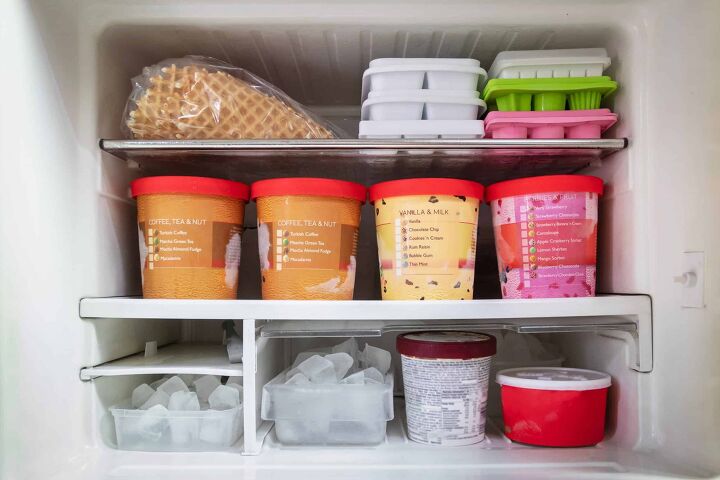Why Doesn't My Freezer Keep Ice Cream Frozen?

One of life’s simple pleasures is a delicious bowl of ice cream after a satisfying meal. That ice cream should be easy to scoop and have a nice, creamy consistency. However, if your freezer doesn’t keep ice cream frozen, then your frozen treat becomes a goopy mess.
If your freezer doesn’t keep ice cream frozen, it’s not cold enough and your freezer isn’t working correctly. Ice cream is less dense than other foods, so when it thaws, this signals an early warning that your freezer needs attention. The problem could be blocked freezer vents, frozen condenser coils, or a malfunction in the appliance.
When you’re stuck with melty ice cream from a warm freezer, you might as well be eating soup. Luckily, if you notice your ice cream melting, you can address the issue with your freezer before your other frozen food spoils.
Do You Need Appliance Repair Services?
Get free, zero-commitment quotes from pro contractors near you.

Reasons Your Freezer Doesn’t Keep Ice Cream Frozen
Several things can cause your freezer to not keep ice cream frozen. If you follow these steps to check on your freezer, you’ll never have soupy ice cream again.
Ice Cream Melts In The Freezer Because Of A Low Temperature
If there is melty ice cream in your freezer, the temperature may be too low. Ice cream does best at a temperature between -5 degrees and 0 degrees Fahrenheit. Most freezers are set at 0 degrees Fahrenheit for their factory settings but can be adjusted higher or lower.
You can control the temperature on your freezer with the freezer temperature controls. Most standalone freezers have a temperature control panel on the inner side or top center. For combination refrigerator-freezers, the temperature control panel is typically on the door or the top center of either side.
Typically, temperature control panels are dials or buttons with a range of numbers. Low numbers mean hotter temperatures, whereas high numbers mean colder temperatures. Freezers will have a recommended setting listed with the temperature control panel.
If your freezer is set below the recommended number, return it to that number. Wait 24 hours for the temperature to change in the freezer. You can play around with the setting a bit to get the desired temperature, but always allow a day for the freezer to regulate.
Improper Environment: Where Is Your Freezer?
Believe it or not, the exterior temperature can affect the temperature inside your freezer. Freezers can’t withstand drastic changes or extremes in temperature. If your freezer is in a place without air conditioning and heat, this could cause your melted ice cream.
Most freezers shouldn’t operate in temperatures above 110 degrees or below 55 degrees Fahrenheit. These extremes can cause problems with your freezer’s internal temperature. Check your freezer’s manual to know what specific temperatures are a problem for your appliance.
If your freezer lives in a garage or basement year-round, this may be the culprit for soft ice cream. Try adjusting the temperature inside your freezer by using the temperature control panel. Put it at a higher number to adjust for heat and humidity. Wait 24 hours for the difference to kick in.
If you do this and still have melty ice cream, it may be time to start storing ice cream inside.
You Open The Freezer Too Much
If your ice cream is melty, you may have opened the freezer door too many times. Every time you open the freezer door, cold air blows out of it. This air loss causes the temperature to drop more and more each time.
Done enough times over a short period, this can begin to thaw food. Decreased temperatures in the freezer can also be caused by the door not shutting properly.
This problem has a straightforward fix. Leave the freezer door closed for a few hours to allow the ice cream to refreeze.
Blocked Freezer Vents
If your ice cream has melted in the freezer, you may have blocked freezer vents. These vents are essential to allowing airflow between your refrigerator and freezer.
If blocked, these vents will not only pose a problem for your ice cream but can freeze the food in your fridge. Blocked vents can also cause a buildup of moisture or frost in the freezer.
If you suspect blocked freezer air vents may be the problem, locate them inside your freezer. If you can’t find them, consult your refrigerator’s manual. Rearrange the food in your freezer to once again allow proper airflow.
If your freezer is packed with food, consider purchasing a wire rack. This will allow you to strategically stack items and leave space for the vents to function appropriately.
Frozen Condenser Coils
Your ice cream may melt if your freezer’s condenser coils are frozen over. Refrigerant continuously cycles through these coils, giving the freezer its cooling power. When the coils accumulate frost, their ability to remove heat from the freezer is limited.
Pull your refrigerator away from the wall and check the coils for frost. Your refrigerator may be in manual or auto-defrost mode.
If it’s in manual, defrost your coils. If it’s in auto-defrost mode and hasn’t defrosted the coils, your refrigerator may be malfunctioning.
An Empty Freezer Doesn’t Keep Ice Cream Frozen
If your ice cream melts, your freezer may not be full enough. While a full freezer can prevent the door from closing, a nearly empty freezer can keep items from cooling. Having a fuller freezer helps food stay colder and helps the freezer maintain its cool temperature.
If you don’t have enough frozen food to fill the freezer, add containers of water to it. This trick fills the space and won’t cost you any additional money.
A Malfunctioning Freezer Doesn’t Keep Ice Cream Frozen
If none of these issues seem to be causing your ice cream to melt, your freezer may be malfunctioning. This is a likely problem if the refrigerator or freezer unit is nearly 20 years old. If it is a newer unit, you may have bought a faulty model.
Consult the manufacturer for suggestions. If this doesn’t provide you with new insights, call a professional for a repair. If the repairmen can’t help, it may be time for a new unit.
Freezer Door Won’t Shut Correctly
If the door to your freezer is not shutting correctly, it may cause melted ice cream. If this is the case, you’ll likely notice other foods thawing out in your freezer as well.
First, open and close the freezer door. The blast of cold air coming from the freezer can sometimes cause the door to pop back open. If this is the case, be sure to give the door an extra push when closing. Keep an eye on it for a second or two afterward to ensure it is closed.
If you have a freezer-refrigerator combo, you may notice the freezer popping open when you close the refrigerator. This trait is common, especially in older models, or if your freezer is a bit overfull.
Be conscious of this when closing your refrigerator door. Make sure to stick around for a moment after shutting the door to ensure the freezer stays closed.
Troubleshooting Your Freezer Door
If your freezer doesn’t seem to stay closed, this can quickly lead to issues with the food inside. Here are a few things to check if your freezer door keeps popping open and your freezer doesn’t keep ice cream frozen.
Your Freezer Is Unlevel
Your freezer door may also have trouble sealing properly if the freezer is not entirely level. Even if you think you shut the door, it can swing open afterward if it is uneven.
Luckily, there is an easy fix for this issue. Place a level on top of the refrigerator or freezer unit and add shims underneath the lower legs. Shims will help stabilize the refrigerator or freezer unit and level it out.
Check Your Freezer’s Gaskets
If you’ve leveled the unit and the door is still popping open, you may need to clean the door gasket. The door gasket is the seal around the edge of your freezer door. If this is dirty or covered in debris, it won’t close properly.
Mix three parts of water with one part baking soda and scrub the door gasket clean. Apply paraffin wax to the hinges for a smoother door swing.
If you notice that the seal has pulled away from the door, attempt to reattach it. There is a track that the seal sits in, and it should be easy to reseat it in the tracks. However, if this doesn’t work, you should replace the door gasket to ensure your freezer door seals properly.
Call A Professional
If you’ve gone through the troubleshooting steps and your freezer still doesn’t keep ice cream frozen, call a pro. The average freezer repair costs about $200. It will likely be more practical to pay for a repair instead of a replacement, especially if your freezer is all-in-one with your fridge.
However, the general rule of thumb is if a repair will cost more than 50% of the price of a new appliance, then replace the appliance.
Related Questions
How can I keep my freezer cold if I lose power?
If you lose power, do not open your freezer door! It may be tempting to try to save your food, but a full freezer can stay cold for about a day if you keep it closed. Opening your freezer too early will ruin your food faster than keeping the door closed. However, if you know that the power outage will last more than a day, remove your food. Do You Need Appliance Repair Services? Get free, zero-commitment quotes from repair pros near you. FIND LOCAL PROS.
Can your freezer be too cold?
A too cold freezer shouldn’t affect your food in the same way a warm freezer does. However, it can raise your electric bill. An extra-cold freezer means your unit is using extra power to keep everything frozen. You may also run the risk of freezer burn on your food when the temperature is too low. However, don’t overcompensate for this by turning the temperature too high. Use your unit’s recommended setting for optimal freezer usage.

Stacy Randall is a wife, mother, and freelance writer from NOLA that has always had a love for DIY projects, home organization, and making spaces beautiful. Together with her husband, she has been spending the last several years lovingly renovating her grandparent's former home, making it their own and learning a lot about life along the way.
More by Stacy Randall













![10 Best Cordless Leaf Blowers – [2022 Reviews & Ultimate Guide]](https://cdn-fastly.upgradedhome.com/media/2023/07/31/9070789/10-best-cordless-leaf-blowers-2022-reviews-ultimate-guide.jpg?size=350x220)
![10 Best Zero Turn Mowers – [2022 Reviews & Ultimate Buyer's Guide]](https://cdn-fastly.upgradedhome.com/media/2023/07/31/9070522/10-best-zero-turn-mowers-2022-reviews-ultimate-buyer-s-guide.jpg?size=350x220)












